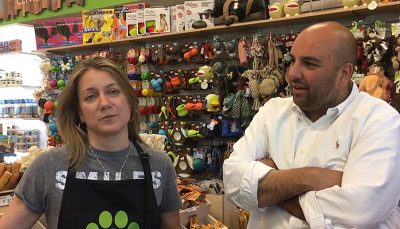Featured in the photo above: Lisa Senafe, Co-Owner and Co-Founder of Bentley’s Pet Stuff, and Giovanni Senafe, Vice President and Co-Founder.
Through a steadfast focus on the brand promise, a successful acquisition strategy, and a little help from The Profit reality TV show host and financier Marcus Lemonis, Bentley’s Pet Stuff is on track to own and operate more than 130 stores by the end of 2018.
Today, Bentley’s Pet Stuff (formerly Bentley’s Corner Café) is co-owned by Senafe’s wife, President and CEO Lisa Senafe and Marcus Lemonis, who is the CEO of Camping World, in addition to hosting The Profit.
Key success strategies for Bentley’s, outlined by Giovanni Senafe, Vice President and Co-Founder, include:
Advertisement
- A subscription delivery service that offers a variety of pet food selections based on a concept of Mixology. “Pets no longer need to eat the same food all the time.”
- Marketing is local: Bentley’s supports local animal shelters, donates “tons of food,” and participates in pet adoption events.
- Real estate occupancy costs are 40% to 60% lower than the average, because Bentley’s stores are not a cookie-cutter size. “We are now known in the landlord landscape as an asset because we are willing to take what’s left.”
- Local control of inventory and store operations: “We allow each store’s staff to run it like they own it. We are built on the backs of our store employees and we will never forget that.”
Giovanni Senafe sat down with Retail TouchPoints for a detailed taste of the secret sauce behind the pet food chain’s success.
Retail TouchPoints: It must have been quite an experience working with Marcus Lemonis on The Profit. What impact did it have on you, your business and your family?
Giovanni Senafe: It was like 100 hours of taping and our son was sick during the taping, so we took a break while he had surgery and was in intensive care. He is healthy now, but Marcus did use it to get me to cry on the show a few times.
For the business, Marcus was a great mentor and we now have a line of credit with him for 20 years. We can make all long-term decisions.
RTP: The pet food industry is very competitive. How does Bentley’s compete?
Senafe: It’s a very fragmented industry. Three players cover about 88% of the market, then the other 12% is divided up by approximately 14,000 independent stores. We don’t have a lot of competition in our space of between 50 and 200 stores. Most of the chains have less than four stores.
Also, while pet food is now sold everywhere — including stores like Walgreens, Tractor Supply and Home Goods — our niche is that our selection is not readily available in a lot of places. And it’s the only healthy pet food made in America.
Additionally, shoppers are now seeing pricing very similar to ours in the big box stores, which helps us. They have added a better product selection, so the price disparity is not as intimidating for consumers.
RTP: Can you talk about your acquisition strategy?
Senafe: We have been able to become a ‘consolidator’ in the industry, because as more retailers offer pet foods, the single-store owners can’t compete. This has fueled our ability to acquire more stores.
[With Marcus’ help], we can do any deal, any size, but we also walk away from more deals than we say yes to. The bad part is we are completely reactive. You can’t wait because someone else will buy them.
To help select locations, we have a Master Broker. With his help we have been able to get an occupancy cost that is 40% to 60% less than our competitors. The reason is, we are willing to take different sized spaces. Each one of stores is very different. We are now known in the landlord landscape as an asset because we are willing to take what’s left.
RTP: Are you also focused on building up your e-Commerce business?
Senafe: Right now about 9% of our sales are online, and that’s still one of the highest percentages in the segment. We plan to keep it at no more than 10%.
We have been offering buy online/deliver to home in Chicago for seven years via SMS, email or calling the store.
We also offer a subscription delivery service, but we do it differently than other e-Commerce players. We didn’t want to just be a pet food delivery company that sends the same bag every 30 days. We will guarantee a bag every 30 days, but our consumers have fun mixing it up. We started a program of Mixology that drives a lot of interaction between shoppers as well as with shoppers and our employees.
RTP: Don’t most consumers want to buy the same food for their pets all the time?
Senafe: That is an old school mentality and it was a great marketing tactic by the big companies. Younger veterinarians have completely changed the face of feeding pets. Millennials can’t comprehend feeding their pets the same food all the time. This change has been fun for us; when we opened our business bags of dog food were 40 lbs. Today they are 22 lbs. or less. As many as 80% of Bentley’s customers buy at least four different foods a year.
RTP: What are your primary vehicles for marketing the brand?
Senafe: YouTube videos, Facebook videos and TV commercials performed the best for us last year. For several years direct mail was number one. But the single biggest thing for us is our relationship with animal shelters. We are known as a huge advocate; we participate in adoption drives and we donate a ton of food, so we attract like-minded consumers. Events are a huge part of how we advertise our brand. It is simple for us; it is beautiful when marketing is talking about what we believe in.
We just hired our first Director of Marketing, who left a $3 billion company to come to us. We’re just now maturing as a company and will start looking more seriously at data and analytics. We’re just getting people in to help define the tools we’ll need.
RTP: As you expand the company well beyond 100 stores across the U.S., how are you able to maintain a consistent brand and customer experience?
Senafe: First, we are lucky because most of the people who work for us were customers or store employees. They believe what we believe. We give our stores a large amount of trust and leniency. It’s simple because our vision and mission never changes.
We allow each store’s staff to run it like they own it. As a result, we have very little turnover. That’s where a lot of retailers get in trouble as they get bigger: they want HQ to be the focal point of the business. We are built on the backs of our store employees and we will never forget that.
Our stores are not cookie cutters. They are all tremendously different. And we don’t do national deals with brands or manufacturers. If something doesn’t sell well in Colorado, we are not going to force it there. If you walk into our 25 Chicago stores, each has 25% to 40% different products.
RTP: What is the interview process like for new employees?
Senafe: We usually throw them for loops. They’re all different. Our approach is simple: Bentley’s is either the best place to work for or the worst place to work for. We like to be up front about our deficiencies. If clarity is their number-one goal, or knowing exactly what they will do tomorrow, we are not the right company for them. We adapt quickly and change based on the market. We try to address that very early on in the interview process.
We are better off hiring somebody that’s trying to build their résumé and learn than somebody who already has worked in the industry. We are not trying to replicate what our competitors have done.
RTP: Do you sell via Amazon?
Senafe: No, not right now. Most of our brands don’t allow it anyway, but I am not naïve enough to think that will not change. Right now, though, it’s not the consumer we’re trying to go after. Our customers value the relationship they can have with Bentley’s. Amazon is still an algorithm looking for the lowest price. Consumers are slowly realizing that paying the cheapest price gets you the cheapest customer service, education and other tangibles.
RTP: You had an advantage in building your business — the help from Marcus Lemonis. What advice do you have for other business executives who don’t have that kind of help?
Senafe: Lay your foundations of your principles on day one and don’t give them up. What attracted Marcus to us was that my wife never wavered on anything. We knew that either Bentley’s was going to make it based on what we believe in or we would shut down and do something else.
It’s good to learn from competitors but don’t try to play a game you can’t win. We are small compared to the behemoths in the industry, like Target and Walmart, but we don’t try to compete with them because we see them changing direction all the time: one day they care more about price, the next day it’s health, and then it may be what’s cute.
Be nimble. If you are small, use it to your advantage. Huge companies are like cruise ships; it could take 84 people in a boardroom to make a decision. You can adapt to the market faster than your biggest competitors.
Featured in the photo above: Lisa Senafe, Co-Owner and Co-Founder of Bentley’s Pet Stuff, and Giovanne Senafe, Vice President and Co-Founder.















